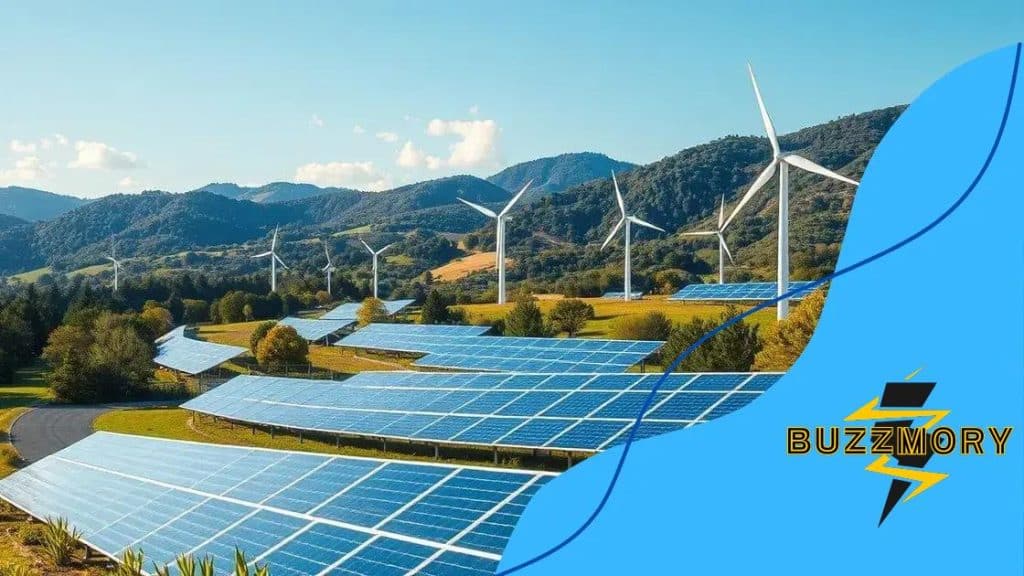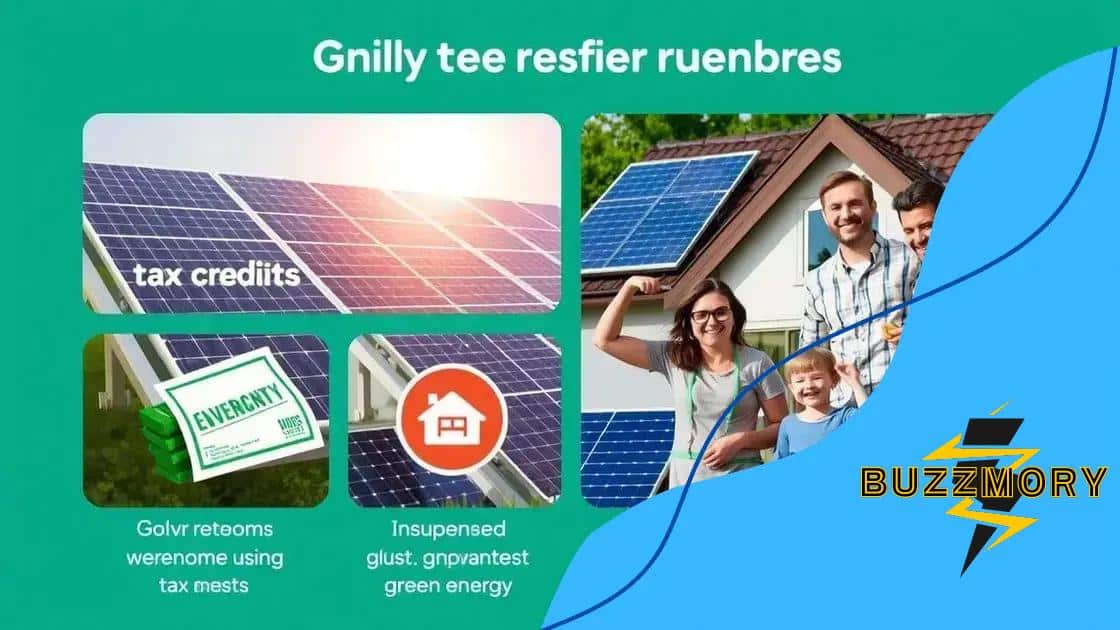Investment opportunities in the green energy sector

Investment opportunities in the green energy sector are growing due to technological advancements, increasing government support, and rising demand for sustainable solutions, making it a lucrative area for future investment.
Investment opportunities in the green energy sector are becoming increasingly appealing as sustainability gains momentum. Have you considered how these opportunities might transform your portfolio?
Key trends in green energy investments
Understanding key trends in green energy investments is vital for making informed decisions in today’s market. As the world shifts towards more sustainable solutions, investors are seeking opportunities that align with environmental goals.
Emerging Technologies
New technologies are reshaping the green energy landscape. Innovations in solar, wind, and battery storage are making alternative energy sources more efficient and affordable.
Government Policies
Supportive government policies play a crucial role in promoting green energy investments. Incentives such as tax credits and subsidies encourage businesses and individuals to invest in renewable energy.
- Tax incentives for solar panel installations
- Subsidies for electric vehicle purchases
- Grants for energy-efficient home upgrades
As policies continue to favor renewable energy, the market is expected to grow significantly in the coming years. This is an encouraging sign for both new and existing investors.
Corporate Responsibility
More companies are prioritizing sustainability in their operations. This corporate responsibility not only enhances brand reputation but also attracts investors who want to support environmentally friendly businesses.
Investing in companies that emphasize green practices can yield positive long-term returns. Furthermore, as consumer awareness grows, businesses that focus on sustainability may outperform their competitors.
Global Energy Demand
The global demand for energy is increasing, and green energy is positioned to play a significant role. As traditional fossil fuel sources deplete, countries are turning to renewable alternatives.
- Growing demand for electricity from renewable sources
- Investment in smart grid technology
- Integration of renewable energy into existing infrastructure
This shift not only benefits investors but also contributes to a more stable and sustainable energy future.
Top sectors for green energy investment
When seeking top sectors for green energy investment, it’s vital to understand where opportunities are flourishing. Various sectors are contributing significantly to the growth of renewable energy.
Solar Energy
Solar energy remains one of the leading sectors for investment. With advancements in technology, solar panels are becoming more efficient and affordable. Governments worldwide are promoting solar initiatives, making it easier for both businesses and homeowners to consider solar options.
Wind Energy
Wind energy is another major player in the renewable sector. As more countries invest in wind farms, the technology has improved, leading to lower costs and higher energy yields. The potential for growth in this sector is enormous.
- Offshore wind farms are gaining traction
- Innovative turbine designs are increasing efficiency
- Government subsidies are making investments more appealing
Investors are paying attention to these developments as they signal a positive outlook for the future of wind energy.
Battery Storage
As renewable energy sources grow, the need for effective energy storage has become crucial. Battery storage solutions are vital for balancing supply and demand. Companies are innovating to create better and cheaper batteries, which enhances reliability in green energy systems.
Electric Vehicles (EV)
The rise of electric vehicles is transforming the transportation sector. Investing in EV technology not only supports sustainability but also aligns with global trends toward reducing carbon emissions. As consumers demand greener transportation options, companies that focus on EVs are likely to see substantial growth.
- Charging infrastructure is expanding
- Government incentives boost EV adoption
- Partnerships with renewable energy firms are increasing
Therefore, investing in sectors linked to electric vehicles can yield promising returns.
Government incentives for green energy

Government incentives for green energy play an essential role in promoting renewable technologies. These incentives can make a significant difference in driving investments and adoption by individuals and businesses alike.
Tax Credits
One of the most common incentives is tax credits. These provide a dollar-for-dollar reduction in tax liability for those who invest in renewable energy solutions. For example, the federal solar tax credit allows homeowners to deduct a percentage of the installation costs of solar panels from their federal taxes.
Grants and Subsidies
Grants and subsidies are financial aids provided by the government to support projects that promote green energy. These funds can help offset the high initial costs of renewable energy technologies. Many programs focus on specific areas such as energy efficiency upgrades or transitioning to electric vehicles.
- Local governments often have additional grant programs
- Subsidies can significantly reduce costs for solar and wind projects
- Assistance is available for businesses looking to go green
These financial incentives are essential for fostering a more sustainable energy landscape. Without them, many individuals may find the upfront costs prohibitive, deterring them from making eco-friendly choices.
Feed-in Tariffs
Feed-in tariffs (FiTs) guarantee a fixed payment for energy produced from renewable sources like solar or wind. This can provide a stable income for individuals and businesses who generate their own energy. By ensuring that producers receive appropriate compensation, FiTs encourage more people to invest in renewable energy technologies.
As these incentives evolve, they are increasingly tailored to meet the needs of local communities. Programs focus on enhancing energy independence and reducing carbon footprints while contributing to job creation in the green energy sector.
Challenges in the green energy market
The challenges in the green energy market are diverse and complex. While the push for renewable energy is strong, several obstacles hinder its rapid growth. Understanding these challenges can help investors navigate this evolving landscape.
High Initial Costs
One of the main barriers to adopting renewable energy is the high initial costs of technology. Many renewable energy projects require substantial investment upfront. This can deter individuals and businesses from making the switch to greener options.
Infrastructure Limitations
Infrastructure is another significant challenge. Many regions lack the necessary infrastructure to support large-scale renewable energy production. Upgrading the grid to handle renewable sources is vital for widespread adoption.
- Transmission lines may not connect to remote solar or wind farms
- Storage solutions for excess energy are still developing
- Investments in public charging stations for electric vehicles are needed
These infrastructure issues can slow down the transition to a greener energy future.
Market Instability
Market instability is a frequent concern for investors looking at green energy. Fluctuating government policies and tax incentives can create uncertainty. Changes in leadership can lead to adjustments in regulations that affect the renewables sector.
Public Perception
The public’s understanding of green energy also presents challenges. Misinformation about the effectiveness and reliability of renewable sources can lead to skepticism. Educating the public on the benefits of switching to green energy is essential for wider acceptance.
Despite these hurdles, the potential for growth in the green energy sector remains vast. Addressing these challenges through innovation and education can pave the way for a brighter, sustainable future.
Future outlook for green energy investors
The future outlook for green energy investors is highly promising as the global focus shifts towards sustainable practices. With increasing awareness of climate change, more individuals and companies are looking to invest in renewable energy. This shift not only benefits the environment but also creates new economic opportunities.
Growth in Renewable Technologies
Renewable technologies like solar and wind energy are projected to keep growing. As innovation advances, the costs associated with these technologies are expected to decrease further. This trend will likely encourage more households and businesses to adopt green solutions.
Government Support
Government policies continue to favor green energy initiatives. This support includes financial incentives, grants, and favorable regulations that encourage investment in renewable energy projects.
- Increased funding for research and development
- Tax credits for renewable energy installations
- Subsidies for sustainable practices in businesses
These attractive policies can spur growth in the sector and attract further investment.
Market Demand for Clean Energy
There is a rising market demand for clean energy sources as consumers become more eco-conscious. Companies committed to sustainability are likely to attract more customers and boost revenues, creating a favorable investment climate.
Technological Advancements
Advancements in energy storage, distribution, and efficiency will also play a crucial role in enhancing the viability of green energy investments. Technologies such as smart grids and improved battery systems will help in better managing renewable energy supply.
Investors will need to stay informed and adjust their strategies as the market evolves. Keeping an eye on trends can help capitalize on emerging opportunities that support a sustainable future.
FAQ – Frequently Asked Questions about Investment Opportunities in the Green Energy Sector
What are the main benefits of investing in green energy?
Investing in green energy offers sustainable growth, potential tax benefits, and contributes to environmental protection.
How do government incentives impact renewable energy investments?
Government incentives, such as tax credits and subsidies, make investing in renewable energy more attractive and financially viable.
What challenges might investors face in the green energy market?
Investors may encounter high initial costs, market instability, and infrastructure limitations when entering the green energy sector.
What future trends should investors watch in green energy?
Investors should pay attention to technological advancements, increasing demand for clean energy, and supportive government policies to guide their decisions.





